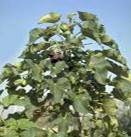| Kingdom | Plantae |
| unranked | Asterids |
| Order | Gentianales |
| Family | Loganiaceae |
| Genus | Strychnos |
| Species | S.ignatia |
| Binomial name | Strychnos ignatia |
Other Common Names:
The other common name for the Ignatius beans is St.Ignatius Bean, Faba Ignatic and Ignatia amara.
History
This large climbing shrub, which is a native of the Philippine Islands, is the source of Ignatia beans. Strychnine was the first alkaloid to be identified in plants of the genus Strychnos, Family Loganiaceae. Strychnos, created by Linnaeus in 1753, is a genus of trees and climbing shrubs of the gentian order. It is the most important genus of the Loganiaceae family. The genus contains 196 various species and is distributed throughout the warm regions of Asia, America and Africa.

Description
Ignatius bean is a climbing shrub or small tree that reaches lengths of more than 60 feet. The plant produces a large spherical or ovoid fruit, measuring 10 centimetres or more in diameter, and containing about a dozen seeds embedded in a pulp, from which they have to be separated. The beans are of a dull, dark grey colour, and irregularly ovoid shape, measuring about 2.5 centimetres in length. Mutual pressure in the fruit has rendered them three, four, or five-sided and bluntly angular.


Range
Ignatius beans are found throughout Southeast Asia and are especially common in the Philippines and in Vietnam. It is also commercially cultivated in china.
Habitat
Although it grows wild, it is also cultivated for commercial purposes. It loves deep, nutrient-rich soils and sites protected from the wind at the edges of forests, fences, and hedges. It is generally seen in jungles.
Cultivation
Ignatius beans are locally cultivated in South East Asia, Pakistan, India and tropical Africa, also in trials. The seeds are the commercial source of strychnine but are mostly collected from wild plants.
Flowering Season
Its flowers are greenish white and covered with small silky hairs which flowers throughout the year.
Pests and Diseases
Ignatii beans are sometimes used as a rodenticide to control rats, mice, and other rodent pests of agriculture and human residences. In this use, strychnine could be considered to be a natural, organic pesticide. Very rarely they are affected aphids and powdery mildew.
Parts Used

The seed and the roots are the most commonly used parts of the plant for its commercial and medicinal value.
Medicinal Applications

• They have been clinically proven to be effective in treating certain forms of heart disease, but must be used under great reservation in order to avoid poisoning.
• Ignatius beans were frequently used as a cheap strychnine substitute for Strychnos nux vomica, because they have similar actions and alkaloidal composition. Ignatius bean is used to treat fever and acute emotional and mental afflictions such as hysteria, insomnia, and depression.
• Ignatius beans are used chiefly as a homeopathic remedy, administered in very small doses.
• It is mostly used in the field of homeopathy for treating hysteria.
• Tonic and stimulant in action like Nux Vomica, which, being cheaper, is nearly always used as a substitute.
• It helps in treating diseases of spinal origin.
• It is a common homeopathic medicine prescribed for digestive problems, sensitivity to cold, and irritability.
Commercial Applications

• In Java and Malaysia the seeds were extracted and used as dart poisons for blowguns and in curare.
• The powdered drug may be administered in cachets or pills with other stomachics and digestives.
• Strychnine is frequently used as a poison for rats and vermin.

The seeds were first brought to Europe in the 15th century, likely as a poison for game and rodents. In 1640, the seeds were first used in European medicine as a stimulant. Jesuits brought the plant from the Philippines to Europe in the 17th century and, it is believed, named it ignatia, or St. Ignatius bean, after the founder of the Jesuit order, Saint Ignatius of Loyola.
Folklore had many to believe that the beans where an effective remedy to cholera. Filipinos traditionally wore the seeds of the Ignatius bean as amulets to protect themselves from disease. The fruit has been called monkey apple because monkeys sometimes eat it. Malaysians called ignatia as a royal poison and historically used the juice of the fruit to poison their for hunting, and occasionally for murdering their human enemies. The crushed seeds were used to neutralise the effects of magical poisonings and love potions, and as a medication against fever and maw-worms.